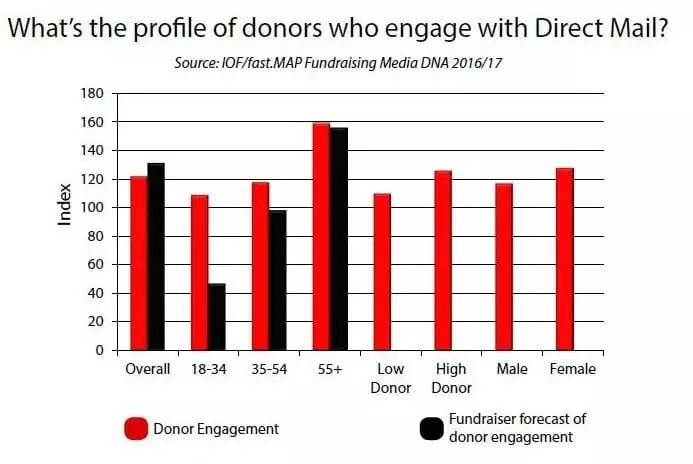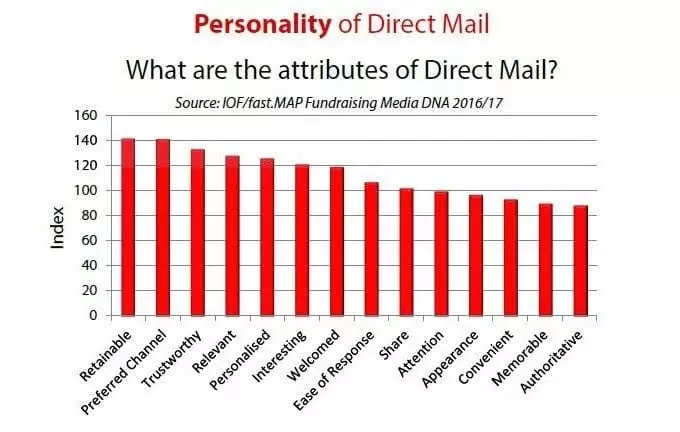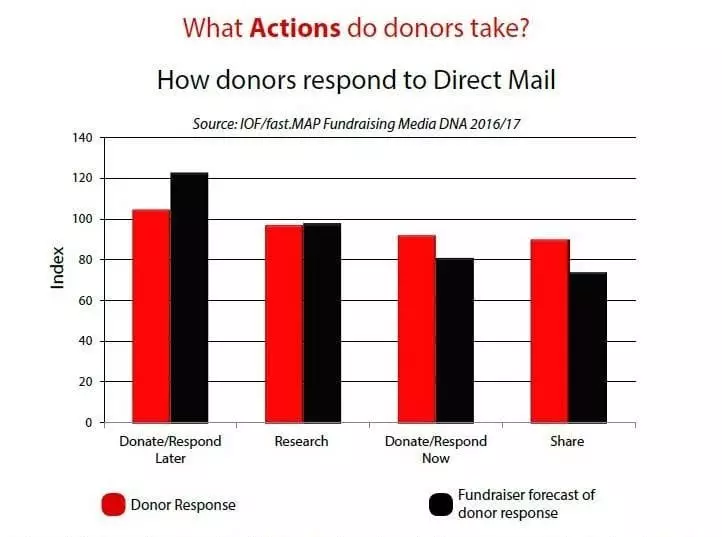Fundraising Media DNA delivers direct mail donor insights
In the latest in our series examining in detail the fast.MAP and the Institute of Fundraising’s Fundraising Media DNA Report, we look at donors’ attitudes to direct mail fundraising.
Key Headlines
• Direct mail plays a key role in engaging a wide range of audiences, especially with the over-55s
• Whilst 18-34s are less engaged, they still score above average on engagement levels. Fundraisers seem to underestimate these figures with younger age groups
• Direct mail’s strongest personality attributes are ‘retainable’, ‘preferred channel’ and ‘trustworthy’
• Donors’ most likely reaction to receiving direct mail is to donate now or respond later
• Download your copy of the Fundraising Media DNA Report and infographic using the free download code UKFU16
Who engages with direct mail?
Direct mail is particularly engaging as a fundraising channel across all profiles, especially among the over-55s. Similar to our 2015 results, fundraisers are well aware of the over-55s’ high engagement level this year (Engagement Index: 55+, Estimate 156 vs. Actual 159). However, they again underestimate mail’s popularity among the 18-34s (Engagement Index: 18-34, Estimated 47 vs. Actual 109) and the 35-54s (Engagement Index: 35-54, Estimated 98 vs. Actual 118). Therefore, they risk under-utilising a powerful communication route to the younger age ranges.

Source: IoF/fast.MAP Fundraising Media DNA 2016/17
Advertisement
What is direct mail’s personality?
Direct mail is a preferred charity communication channel for donors (Preference Index: Overall, 141). People like direct mail because it is trustworthy (Trustworthy Index: 55+, 145) and they sometimes keep it for future reference – the ‘mantelpiece effect’.
Being a lasting, tangible and physical channel, unsurprisingly, retention is one of Direct Mail’s strongest attributes (Retainable Index: Overall, 141). People regularly keep direct mail packs for reference, with nearly half of consumers (48%) occasionally keeping an item of interest. Moreover, 17% of these consumers do so regularly (fast.MAP Report for the DMA ‘From Letterbox to Inbox’).
For this reason, it is wise to include links to information sources and include various reply routes to prompt response by whichever means is most convenient.

Source: IoF/fast.MAP Fundraising Media DNA 2016/17
Despite their lower engagement scores, younger people are more likely to share direct mail information than older audiences (Share Index: 18-34, 127; 34-54, 92; 55+, 74).
Surprisingly, direct mail has a below average memorability score (Memorable Index: Overall, 89) and since the most common reaction is to donate or respond later (Donate/Respond Later Index: Overall, 105), fundraisers may wish to use this insight to consider the inclusion of devices to prompt a faster response, such as reinforcing the message across several channels or including a deadline.
How do donors respond to direct mail?
The most likely reaction to a direct mail appeal is to donate or respond later (Donate/Respond Later Index: Overall, 105). This is especially true for the over-55 profile (Donate/Respond Later Index: 55+, 115). However, as they did in 2015, fundraisers still overestimate the likelihood of donors responding later to an appeal (Donate/Respond Later Index: Estimated 123 vs. Actual 105).
The fact that delayed responses to direct mail are more likely than immediate responses is unsurprising (Donate/Respond Now Index: Overall, 92; Donate/Respond Later Index: Overall, 105), given its retainability score as mentioned earlier (Retainable Index: Overall, 141). People are likely to keep it for future reference, especially if they want to take more time to read and digest the information. Fundraisers perhaps need to use direct mail with other fundraising channels to help drive response, e.g. sending an email reminder. They may also want to consider including a deadline to encourage response by a particular time, e.g. for a Christmas appeal.

Source: IoF/fast.MAP Fundraising Media DNA 2016/17
What do people say about direct mail?
“As a one-to- one medium, direct mail has traditionally been strong in the areas of targeting and personalisation and this is reflected by it being seen by all the groups as being ‘relevant to my likes and dislikes’, with the highest scores in the female and, perhaps surprisingly, the 18-34 groups. Ensuring that the mailing is relevant to the recipient has also made sure that direct mail is considered to have ‘interesting content’.”
Claire Gingell, Head of Marketing, ONEPOST
“Direct mail is one of the most consistent and successful fundraising channels. However, as more technically creative and innovative communications develop, perhaps less attention in recent years has been given to more tried and trusted fundraising campaigns and channels.”
“Similar to last year, fundraisers seem to be underestimating the engagement levels with direct mail – particularly amongst 18-34s. While the focus on new and emerging channels is of course welcome, fundraisers should be thinking about how these can be complemented and enriched with postal communication.”
Daniel Fluskey, Head of Policy and Research, Institute of Fundraising
“More traditional media, such as direct mail, still play a key role in engaging a wide range of audiences. Research shows that this includes younger donors as well as the over 55s, which suggests that we have to move away from stereotypically assigning ‘old’ media with older age groups.
“It is important that charities consider what messaging will work for each audience, as it will not necessarily be the same proposition and execution for each group. Pre-testing campaigns via online research can help identify what appeals to who – and why.”
David Cole, Managing Director, fast.MAP
Fundraising campaigns can be tailored to be more efficient and effective for different age groups when assumptions and generalisations aren’t made, but instead, research is conducted.
To find out more about how people view and interact with different fundraising channels, download Fundraising Media DNA 2016/17 – free, (normally £50) with the following code: UKFU16.



